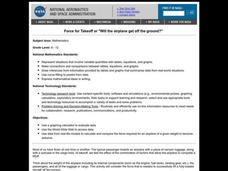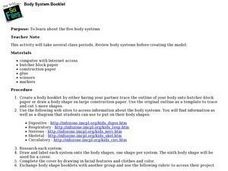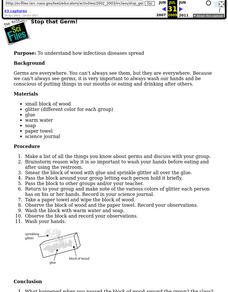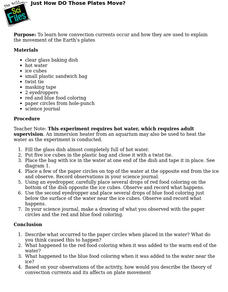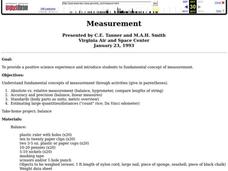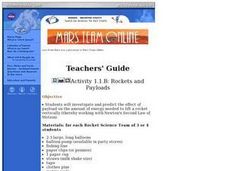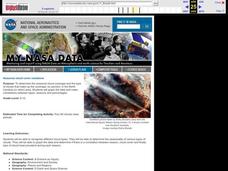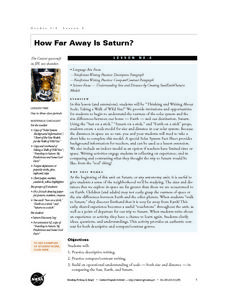Curated OER
Math: Will The Airplane Get Off the Ground?
Students use data from real-life models to calculate and compare the force required for an airplane of a given weight to become airborne. They use a graphing calculator to evaluate data and use the World Wide Web to access data.
Curated OER
Untitled Document Aerospace Team Online:
Students explain the historical significance of use of the scientific method in developing the first airplane and appreciate the process involved in developing a new technology.
Curated OER
Weightlessness
Students use a coffee cup to demonstrate weightlessness. After a lecture/demo, students read an article on free-fall. They perform a simple experiment which helps them explain the concept of weightlessness.
Curated OER
Making a Body System Booklet
Pupils create a body booklet by having their partner trace the outline of their body onto butcher-block paper.
Curated OER
The Evolution Of Bicycling Technology
Students discover how the design of bicycles has changed over time as technology has developed. They use the Web to research bicycle history and then write a report showing how technology changed the way the bicycle looks and works.
Curated OER
A Model of Earth's Tectonic Plates
High schoolers build a model of the Earth showing tectonic plate boundaries. The pattern for the model is provided in the instructional activity. This is a very useful hands-on component for a instructional activity about geology or...
Curated OER
Earthquake, Earthquake, Read All About It!
Students utilize the U.S. Geological Service web site. They research the various types of scales used to measure earthquakes and classify different situations on the scale. They write a story about a town that has just experienced a quake.
Curated OER
You Got The Whole World In Your Hands: Geology, Earth's Layers, Science
Pupils make a model of the Earth's crust out of foam in order to better explain the make-up of the Earth's layers. They add continents and oceans.
Curated OER
Stop that Germ!
Students experiment with glitter to explain the importance of washing hands and how germs are distributed. After a lecture/demo, students perfom a simple experiment which clearly demonstrates how germs are spread.
Curated OER
Just How DO Those Plates Move?
Students experiment with water, temperature and paper to explore how convection currents occur and how they are used to explain the movement of the Earth's plates.
Curated OER
As the World Turns: The Coriolis Effect: Global Wind Patterns, Earth's Rotation
Middle schoolers use pencil and paper to explore the Coriolis effect and how the Earth's rotation causes global wind patterns.
Curated OER
Nice Angle
Students experiment with paper, light, thermometers and measurement to explore how the Sun's angle affects the temperature on Earth.
Curated OER
#2 Pencil Innovations: Inventions, Science
Ask your class to consider a #2 Pencil to show how inventive thinking can be stimulated by making innovations to an everyday object. There is also an interesting extension included that refers to a book about the history of the pencil....
Curated OER
Finding Your Center of Gravity: Science, Math, Measurement, Math
Students use bathroom scales, rulers and boards to explore how to measure their own center of gravity.
Curated OER
Science Journal Writing: Observation, Problem Solving
Students consider the value of keeping a science journal. They make a journal and prepare the first entries.
Curated OER
Measurement
Young scholars experience a positive science experiment and study fundamental concepts of measurement.
Curated OER
Classification of Clouds
Students view a cloud slide show presentation and identify types of clouds. They estimate height based on cloud's appearance. They discuss the vague nature of cloud nomenclature and compare it to the English standard measurement system.
Curated OER
Sun, Shadows, Surface Structure...and the Face on Mars
Students use light and shadow information to make inferences regarding the three dimensional shapes of specific objects photographed on the surface of Mars. Limitations of the of the data provided are discussed and entries made into the...
Curated OER
Modeling Martian Motion
Students explore the difference between stars and planets and take on the role of these objects to simulate the relative motions of Mars and the Earth around the Sun.
Curated OER
Rockets and Payloads
Students investigate Newton's Second Law of Motion as they predict the effect of a payload on the amount of energy needed to lift a rocket vertically. The constraints of the weight of the equipment carried to Mars is compared to the...
Curated OER
Seasonal Cloud Cover Variations
High schoolers recognize different cloud types. They determine the seaonality of various types of clouds. They graph the data and determine if a correlation exists between season, cloud cover and type of clouds most prevalent during each...
Curated OER
Using Mathematic Models to Investigate Planitary Habitablity
Students examine how the sun's intensity affects the temperature on various planets. They determine whether or not these planets could be habitable. Finally, they factor in the average albedo of the planets to determine whether or not...
Curated OER
Awesome Saturn
Students brainstorm words that describe Saturn. They view images sent to Earth from satellites. They write poems about the planet using different poetic forms.
Curated OER
How Far Away Is Saturn?
Students work together to create a scale model of the solar system. They write a descriptive paper and a paper comparing and contrasting the Earth to Saturn. They discuss their writings with the class.
Other popular searches
- Nasal Passages
- About Nasa
- Nasa Planets
- Nasa Robots
- Nasa Lesson Math
- Nasa Aircraft
- Nasa Materials
- History of Nasa
- Nasa Lesson Plans
- Nasa Web Based Textbook
- Nasa Aurora
- Contributions of Nasa


